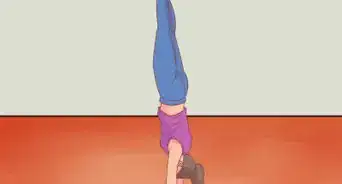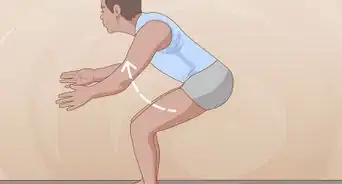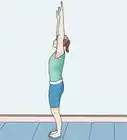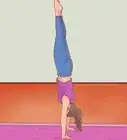X
wikiHow is a “wiki,” similar to Wikipedia, which means that many of our articles are co-written by multiple authors. To create this article, 25 people, some anonymous, worked to edit and improve it over time.
This article has been viewed 78,916 times.
Learn more...
A front limber is the natural next step after you've mastered a handstand. It's a beautiful move in which you kick into a handstand and drop your legs backward, then rise to your feet in one fluid motion. Once you get the hang of it you won't be able to stop doing it. See Step 1 to start practicing.
Steps
Part 1
Part 1 of 3:
Getting Prepared
-
1Develop a solid handstand. It's important to have mastered the handstand before you attempt to do a front limber.[1] Practice your handstand every day until you've perfected your form and you feel confident about moving on. If you are having trouble with this, you might not be ready just quite yet. If you need a refresher, here's how to do a handstand:
- Stand on a flat surface with your legs spaced comfortably apart. Make sure your arms are up ready to go.
- Take a big step forward with your dominant leg. In the same motion, tip your body forward over your lunged leg and place your hands on the ground, with your shoulders pulled close to your head.
- Kick your legs up into the air, keeping them straight with your toes pointed toward the sky.
- Keep your head between your arms and look at your hands as you balance.
-
2Make sure you have a good back bend. You should also be able to perform a back bend from a standing position. Perfect your backbend by practicing for many hours before doing a limber. Here's how to do a backbend from a standing position:
- Stand up straight with your feet shoulder width apart.
- Raise your arms over your head and flatten your palms so they face the ceiling.
- Slowly bend backwards toward the floor, keeping your arms locked.
- Plant your hands on the ground, keeping your feet in place. Your body should be in an arc shape.
Advertisement -
3Stretch for several minutes. If you're confident that you've mastered all the fundamentals, it's time to get ready to do a front limber. Get ready by stretching for several minutes to warm up your muscles.
- Stretch your back by touching your toes, twisting from side to side, and doing some simple yoga techniques.
- Stretch your wrists by rolling them in circles, then using one hand to pull back the fingers of the other hand (and vice versa).
- Get your whole body warmed up by jogging around the block a few times.
- Practice your handstand and backbend a couple of times to get the motion down. Now you're ready.
-
4Have a spotter and the right equipment on hand. The first few times you do a front limber, you should have a spotter nearby to support you. You might also want to use a barrel mat so that you'll won't have far to fall if you lose your balance. In any case, you should practice any new gymnastic move on supportive mats that will protect your wrists, feet and other pointy body parts.
Advertisement
Part 2
Part 2 of 3:
Perfecting Your Form
-
1Kick up into a handstand. Hold it at the top for a few moments. If you're feeling nice and steady, proceed to the next step. If you're wobbly, drop down and start over. You need to have a good, solid handstand before you attempt a front limber.[2]
-
2Push your shoulders out and arch your back. While you'd usually want to keep your back perfectly straight for a handstand, this time you want to arch it backward while pushing your shoulders out away from your head a bit. Your legs will naturally begin to arc toward the floor.[3]
- Keep your toes pointed until they reach the floor.
-
3Bend your legs and plant your feet on the floor. You should land in a bridge position, as though you'd just completed a backbend.[4]
- Keep your head back. It helps to keep your eyes on your hands.
-
4Shift your weight to your feet and stand. In one fluid motion, you should plant your feet and move your weight forward so that you can stand up straight. You'll press your hips forward to lift your torso and head upright.[5]
- Land with your feet about a foot apart. This will help you keep your balance and lift yourself up.
- From the moment your hands leave the floor, keep your arms straight on either side of your head. They should be upright for your landing.
Advertisement
Part 3
Part 3 of 3:
Taking the Natural Next Step
-
1Try a front walkover. It's very similar to a front limber, except you drop one foot before dropping the other. Once you've got the limber down, this should be easy.
-
2Do a front handspring. This flashy move takes a lot of practice, so make sure you've perfected the preliminary moves before attempting it.
-
3Do a back walkover. The approach is quite different; you do a backbend, then lift your legs over your body.
-
4Do a back handspring. It's a wildly impressive move that cheerleaders often do. You'll need a lot of upper body strength to accomplish this one!
Advertisement
Community Q&A
-
QuestionHow can I hold my handstand long enough when I'm doing a limber?
 Community AnswerMake sure your legs aren't too far to one side or the other. Practice kicking up onto a wall to prevent kicking too far, or too little.
Community AnswerMake sure your legs aren't too far to one side or the other. Practice kicking up onto a wall to prevent kicking too far, or too little. -
QuestionWhat can I do if I am scared to fall?
 Community AnswerYou can start by doing half of the move. For example if you are scared to do a backbend, work on doing half by bending your back, and instead of reaching for the floor, reach for a chair or a sofa. If it is for stuff like walkovers, then instead of using a mat or if you dont have a mat use multiple blankets and pillows, that will make it a less heavy fall if you lose your balance.
Community AnswerYou can start by doing half of the move. For example if you are scared to do a backbend, work on doing half by bending your back, and instead of reaching for the floor, reach for a chair or a sofa. If it is for stuff like walkovers, then instead of using a mat or if you dont have a mat use multiple blankets and pillows, that will make it a less heavy fall if you lose your balance. -
QuestionI am having trouble standing up. Any tips?
 Community AnswerPut all your weight into your legs. Then, push your belly button up toward the ceiling. Don't look up until you're standing. If this doesn't work, film yourself doing a back bend and play it in reverse.
Community AnswerPut all your weight into your legs. Then, push your belly button up toward the ceiling. Don't look up until you're standing. If this doesn't work, film yourself doing a back bend and play it in reverse.
Advertisement
Warnings
- Practice on a soft surface such as a mat, grass, or carpet.⧼thumbs_response⧽
- If you don't feel comfortable yet doing your limber, have a parent or coach spot you.⧼thumbs_response⧽
- You may fall, so be careful.⧼thumbs_response⧽
Advertisement
References
About This Article
Advertisement



















































